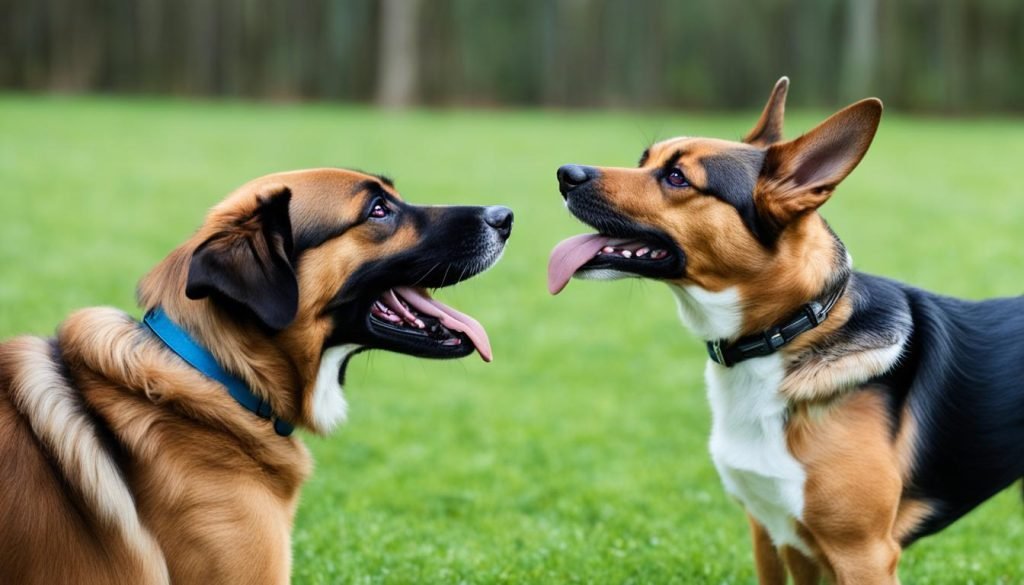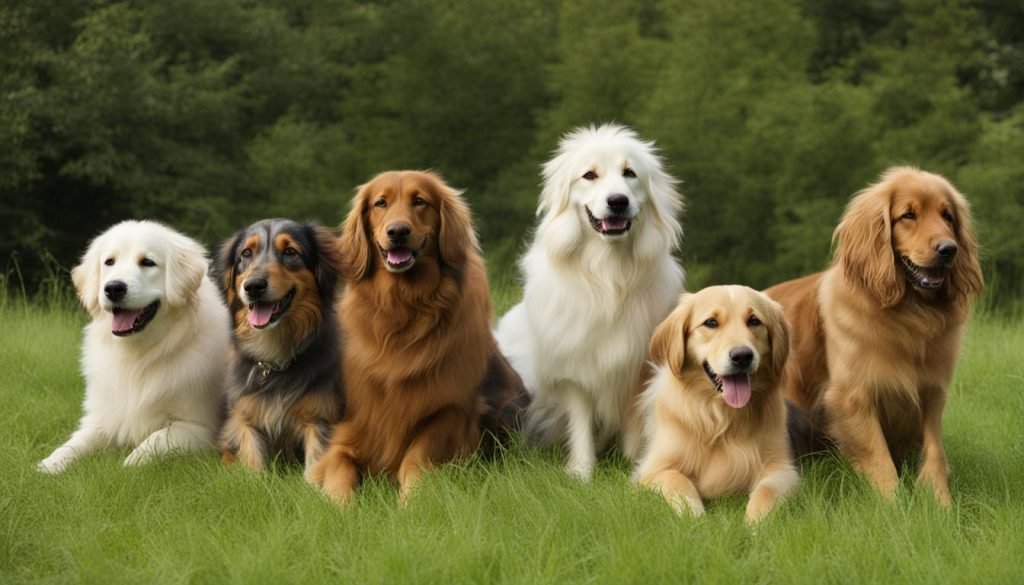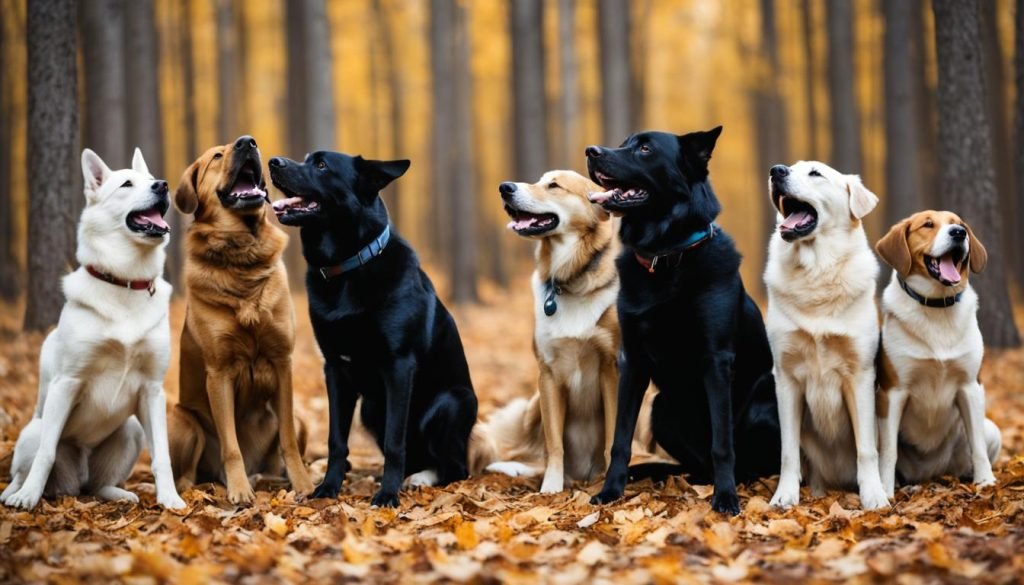How Do Dogs Communicate With Each Other?
Dog communication is a fascinating subject that involves the use of multiple senses, including smell, sound, and visual cues. Just like humans, dogs have their unique ways of expressing themselves and understanding each other.
By delving into the world of canine communication, we can gain valuable insights into their behavior and build stronger connections with our furry friends.
So, how do dogs communicate with each other? Let’s explore the various methods they employ to convey their needs, emotions, and intentions.
Key Takeaways:
- Dogs rely on a combination of body language, vocalizations, and scent to communicate with each other.
- Understanding and interpreting dog body language is crucial for deciphering their emotions and intentions.
- The power of scent plays a significant role in canine communication, with dogs using scent marking to convey important messages.
- Vocalizations such as barks, whines, and growls also serve as communication tools for dogs.
- Play behavior and social hierarchy further contribute to canine communication and socialization.
The Role of Body Language in Canine Communication

Dogs primarily communicate through body language, using specific postures and movements to convey their emotions and intentions. Understanding dog body language is fundamental to interpreting their messages accurately. By paying close attention to their body language signals, we can decipher what dogs are trying to communicate and respond appropriately.
Some important body language signals to watch for include:
- Head and Neck Position: How a dog holds its head and neck can provide valuable information about their state of mind. A confident dog typically holds its head high, while a fearful dog may lower its head and avoid eye contact.
- Ear Position: The position of a dog’s ears can indicate their level of attentiveness, arousal, or aggression. Erect ears may signify alertness, while flattened ears could indicate fear or submission.
- Tail Position and Activity: A dog’s tail can convey various emotions. A wagging tail generally indicates happiness, while a tucked tail might signal fear or submission.
- Facial Expressions: Dogs have a wide range of facial expressions that can reflect their emotions. Pay attention to cues like relaxed or tense lips, raised or furrowed brows, and the presence or absence of wrinkles.
- Vocalizations: Although primarily a form of communication on its own, vocalizations such as barking, growling, whining, or whimpering can accompany specific body language signals and provide additional context.
By combining these body language signals with vocalizations and other nonverbal cues, we can gain a deeper understanding of what dogs are trying to convey. Reading their body language accurately allows us to respond appropriately and create a positive and trusting relationship with our canine companions.
The Power of Scent in Canine Communication

Canines have an extraordinary sense of smell, with as many as 300 million olfactory receptors in their noses. This remarkable ability plays a crucial role in their communication with other dogs. Scent marking is one of the primary methods dogs use to convey important information to their counterparts.
Through scent marking, dogs leave messages for one another, sharing details about their health, sex, diet, social status, and mood. This form of communication involves sniffing and urinating on various objects to establish a presence and communicate specific messages.
“Scent marking is the equivalent of leaving a personalized note or a social media update for other dogs to read.”
Scent marking serves as a way for dogs to establish territory, claim ownership, and communicate their reproductive status. Additionally, it helps dogs assess the presence and current state of other dogs in their surroundings.
Common Scent Marking Behaviors in Dogs
| Behavior | Description |
|---|---|
| Urine Marking | Dogs urinate on vertical surfaces, such as trees or walls, to leave a scent message. |
| Ground Scraping | Dogs use their paws to scratch the ground after urinating, spreading their scent further. |
| Scent Rolling | Dogs roll their bodies on specific scents to transfer the smell onto themselves, potentially signaling affiliation or investigating unfamiliar scents. |
| Anogenital Scent Investigation | Dogs sniff the anogenital area of other dogs to gather information about their social status and reproductive readiness. |
| Anal Gland Secretion | Anal glands release scent markers that can communicate additional information to other dogs. |
Scent marking is a fundamental component of canine communication. It allows dogs to exchange complex messages, establish social connections, and navigate their environment effectively.
Vocalizations in Canine Communication

While canine communication methods predominantly rely on body language and scent, vocalizations such as barking and growling play a significant role in dogs’ communication repertoire. Dogs use various types of vocalizations to convey their emotions, intentions, and needs.
Barking, the most common vocalization can serve as an alert, a territorial display, an expression of fear or anxiety, or an invitation to play. Different barks may have distinct pitch, duration, and intensity, signifying different messages.
Growling, another vocalization commonly associated with dogs, can indicate a perceived threat, aggression, or discomfort. It serves as a warning signal, indicating that a dog may be defensive or in an antagonistic state.
Whines and yips are higher-pitched vocalizations that dogs use to communicate distress, anxiety, or excitement. These vocalizations can indicate a range of emotions, from discomfort to anticipation.
Interpreting Canine Vocalizations
Decoding the meaning behind canine vocalizations requires careful observation of contextual cues and accompanying body language. A bark that is accompanied by an erect posture and forward-facing ears may indicate an alert or territorial response, whereas a bark accompanied by a crouched posture and tail tucked between the legs may signal fear or submission.
Understanding the different contexts in which dogs vocalize and the corresponding body language can help pet owners and observers interpret their messages accurately. It is essential to consider the overall communication methods of dogs, including body language, scent-marking, and vocalizations to gain a comprehensive understanding of canine communication.
| Canine Vocalization | Meaning | Associated Body Language |
|---|---|---|
| Barking | Alert, territorial display, fear, invitation to play | Varies depending on the emotion |
| Growling | Perceived threat, aggression, discomfort | Defensive posturing, raised fur, intense staring |
| Whining, yipping | Distress, anxiety, excitement | Varies depending on emotion |
Understanding canine vocalizations is crucial for effective communication with dogs and ensuring their well-being. By paying attention to the accompanying body language and observing the context in which vocalizations occur, pet owners can respond appropriately to their furry companions’ needs and emotions.
Play Behavior and Social Hierarchy in Canine Communication
Play is an essential aspect of canine communication and socialization. Dogs engage in play to establish social bonds, hone their social skills, and convey their intentions to other dogs. Play behavior encompasses a range of activities, including chasing, wrestling, and play-bowing. Additionally, dogs have a social hierarchy that governs their position within a group, and they employ body language and posture to communicate their social status.
The various play behaviors exhibited by dogs serve multiple purposes. Play allows dogs to practice and refine their physical skills, such as coordination, agility, and speed. It also helps them develop and enhance their social skills, including understanding boundaries, interpreting body language, and communicating intentions.
Play behavior includes activities such as chasing, wrestling, and play-bowing.
During play, dogs may take on different roles within a social hierarchy. This hierarchy refers to the ranking or position that dogs have within a group based on dominance and submission. It plays a crucial role in shaping their behavior and interactions. Dogs use body language, posture, and vocalizations to establish and maintain their social status within the group.
Examples of Dog Play Behavior:
- Chasing: Dogs engage in playful chasing behavior to mimic hunting and to show dominance or submission.
- Wrestling: Playful wrestling allows dogs to practice their physical skills, establish social bonds, and determine their place in the social hierarchy.
- Play-bowing: Dogs perform a play-bow by lowering their front body while keeping their rear end elevated. It signals an invitation to play and displays non-threatening behavior.
Play behavior facilitates socialization and strengthens bonds within the canine community.
Understanding Conflict-Related Behaviors in Dogs
Dogs, like humans, can experience inner conflicts when faced with contradictory or competing motivations. These conflicts often manifest through their behavior, serving as signals to communicate with other dogs. By understanding and interpreting these conflict-related behaviors, we can better respond to their needs and prevent negative outcomes such as aggression.
One common conflict-related behavior in dogs is raising a front paw. Dogs may raise their paw as a sign of uncertainty or hesitation when they are unsure how to respond in a particular situation. This behavior can be observed when a dog encounters a stimulus that elicits both curiosity and caution.
Another conflict-related behavior is lying down. When a dog lies down, it can be an indication of conflicting emotions. It may signal a desire to avoid confrontation or escape from a stressful situation. By recognizing this behavior, we can provide a calmer environment and help our dogs feel more comfortable.
Understanding conflict-related behaviors involves observing the dog’s body language, which is a crucial aspect of canine communication. Dogs use their body postures and movements to convey various emotions and intentions. By paying close attention to their body language, we can gain valuable insights into their internal conflicts and respond appropriately.
Additionally, it’s important to consider the context in which these behaviors occur. Dogs may display conflict-related behaviors in situations where they are torn between their natural instincts and learned behaviors. For example, a dog may experience conflict when it wants to chase a squirrel but has been trained to stay by its owner’s side.
By recognizing and acknowledging these conflicts, we can help our dogs make better choices and manage their behavior effectively. Using positive reinforcement training methods and providing clear guidance can contribute to resolving these conflicts and promoting the overall well-being of our furry friends.
Understanding Conflict-Related Behaviors Summary
| Behavior | Meaning |
|---|---|
| Raising a front paw | Uncertainty and hesitation |
| Lying down | Desire to avoid confrontation or escape |
Submissive and Appeasement Signals in Canine Communication
Canine communication involves a wide range of behaviors and signals that dogs use to convey their emotions and intentions. One important aspect of canine communication is the use of submissive and appeasement signals. These signals are employed by dogs to diffuse conflicts and reduce potential threats within their social interactions. By recognizing and responding appropriately to these signals, dog owners and enthusiasts can promote a positive social dynamic and prevent aggression.
Submissive and appeasement signals encompass various behaviors that dogs use to signal their non-threatening intentions. Some of these signals include:
- Avoiding direct eye contact
- Yawning
- Nose-licking
- Lowering ears and head
- Twisting the neck sideways
- Holding the tail low or between the legs
- Rolling over to expose the abdomen
When dogs display these behaviors, they are communicating their desire to establish harmony and de-escalate any tension or potential conflict. These signals indicate that the dog is not a threat, allowing other dogs to feel more at ease in their presence.
Dog owners and handlers must understand and properly interpret these submissive and appeasement signals. By being able to identify these behaviors, individuals can respond in ways that support a calm and safe environment for both dogs and humans present.
Recognizing and appropriately responding to submissive and appeasement signals can prevent aggression and maintain a positive social dynamic between dogs. It is essential to create an environment where all dogs involved feel comfortable and secure, reducing the likelihood of conflicts and promoting healthy canine interactions.
Understanding Guilt and Miscommunication in Canine Communication

When dogs display submissive postures following undesirable behaviors, it is often misinterpreted as guilt by their human companions. However, these postures are not indicative of guilt but rather an attempt to appease and avoid punishment. Dogs have learned to associate certain human body language cues or previous punitive experiences with these submissive signals, leading to miscommunication between humans and dogs.
Dog owners and enthusiasts need to understand this misinterpretation and recognize the true meaning behind submissive signals. By doing so, we can establish more effective communication channels with our canine companions and foster a stronger bond based on trust and understanding.
Instead of attributing human-like emotions such as guilt to our dogs, it is crucial to interpret their behavior through the lens of their natural communication methods. Dogs primarily rely on body language, vocalizations, and scent cues to convey their needs, emotions, and intentions. By paying close attention to these signals, we can better understand their communication and respond accordingly.
Recognizing submissive postures in dogs is the first step towards unraveling the miscommunication that often occurs. Common submissive signals include avoiding direct eye contact, lowering the head and ears, tucking the tail between the legs, and rolling over to expose the abdomen. When displayed in the absence of recent misbehavior, these signals should not be mistaken for guilt.
Instead, think of these submissive postures as a way for dogs to diffuse conflict or reduce a perceived threat. By assuming these postures, dogs are trying to communicate their non-confrontational intentions to avoid escalating the situation. Understanding and respecting their communication signals can prevent aggression and foster harmonious interactions.
“Misinterpreting a dog’s submissive postures as guilt can lead to misunderstandings, strain the human-dog bond, and inadvertently reinforce unwanted behaviors.”
By dismantling the concept of dog guilt and focusing on understanding their communication methods, we can build a stronger connection with our canine companions. This includes being aware of our body language and actions, as dogs are highly perceptive to human cues. By providing clear and consistent cues, we can establish trust and facilitate effective communication.
Ultimately, the key to bridging the communication gap between humans and dogs lies in recognizing the true meaning behind their signals, avoiding anthropomorphic interpretations, and respecting their canine perspective.
The Importance of Canine Communication for Humans
Dogs possess a remarkable ability to understand human nonverbal behavior, while we often struggle to decipher their subtle forms of communication. By gaining insight into how dogs communicate with us, we can foster stronger relationships and enhance their overall well-being. Paying close attention to their body language, vocalizations, and use of scent allows us to better comprehend their needs, emotions, and intentions, ultimately forging a deeper bond between humans and dogs.
Canine communication with humans revolves around various methods, each conveying its unique message. Dogs utilize their body language to express themselves, relying on postures, movements, and facial expressions. By familiarizing ourselves with these signals, such as a wagging tail indicating happiness or a lowered posture denoting fear, we can better understand our canine companions.
In addition to body language, dogs communicate vocally, using barks, growls, and whines as a means of expression. Each vocalization carries its significance and can communicate emotions like excitement, frustration, or fear. By being attentive to the context and accompanying body language, we can accurately interpret their vocal cues.
Furthermore, dogs communicate through the power of scent. They rely on their heightened olfactory senses to gather information about their environment, other dogs, and humans. By recognizing scent-based communication methods, such as sniffing or marking territory, we can gain valuable insights into their interactions and experiences.







